AHOK: SIMBOL ANOMALI BAHASA KELAS PENGUASA
 Abstract views: 609
,
Abstract views: 609
,
 PDF downloads: 288
PDF downloads: 288
Abstract
One of the distinguishing features between the ruling class with the lower class is language. The higher stratum of someone then he has a tendency to use the language as well as, as smooth as, or as a good order as possible. But this credo does not apply to Basuki Tjahaja Purnama called Ahok, as Head of Jakarta region, he communicates in a language far from polite, smooth, and well, sometime he uses rough language, gratuitous, even invective. Ahok selected to be analyzed because in the social fact Ahok is deemed to have a behavior that is controversial that reveals the good government jargon without corruption and nepotism with languages that are far from a good order of language used by the elits. This article tries to analyze and compare the language of politics that used by Ahok that represent the ruling class of the ruling in a metropolis and became the capital of the State in the reform era (freedom) with the language used in the era of Soeharto.
Downloads
References
Bibliography
Chaer, A., & Agustina, L. 2004. Sosiolinguistik: Perkenalan Awal. Jakarta: PT Rineka Cipta.
Crystal, D. 2008. A Dictionary of Linguistics and Phonetics. Oxford: Blackwell Publishing Ltd.
Heryanto, A. 1992. Pembakuan Bahasa dan Totalitarianisme. Seminar Bahasa dan Sastra se-Jawa Timur (p. 252). Surabaya: Hima Prodi Bahasa dan Sastra Indonesia.
Holmes, J. 2001. An Introduction to Sociolinguistics. Essex: Pearson Education Limited.
Homes, J. 2001. An Introduction to Sosiolinguistics. Essex: Pearson Education Limited.
Kadarisman, A. E. 2010. Mengurai Bahasa Menyimak Budaya. Malang: UIN Maliki Press.
Kaelan. 2002. Filsafat Bahasa: Masalah dan Perkembangannya. Yogyakarta: Paradigma.
Koto, F. 2016. Ahok Gubernur 3M: Marah, Maki, Menuduh. Surabaya: -.
Kridalaksana, H. 2001. Kamus Linguistik. Jakarta: PT Gramedia Pustaka Utama.
Labov, W. 2006. The Social Stratification of English in New York City. Cambridge: Cambridge University Press.
Latif, Y., & Ibrahim, I. S. 1996. Bahasa dan Kekuasaan Politik Wacana di Panggung Orde Baru. Bandung: Mizan Pustaka: Kronik Indonesia Baru.
Mallinson, C. 2007. Social Class, Social Status and Stratification:Rivisiting Familiar Concepts in Sociolinguistics. University of Pennsylvania Working paper in Linguistics, 151.
Pabottinggi, M. (1991, Februari No. 2). Bahasa, Kramanisasi, dan Kerkayatan. Prisma, pp. 16-26.
Poloma, M. M. 2010. Sosiologi Kontemporer. Jakarta: PT Raja Grafindo Persada.
Putten, J. v. 2010. Bongkar Bahasa: Meninjau Kembali Konsep yang Beraneka Makna dan Beragam Fungsi. In M. Moriyama, & M. Budiman, Geliat Bahasa Selaras Zaman (p. 18). Jakarta: KPG (Kepustakaan Populer Gramedia).
Ripangi, A. 2013. Sisi Lain Ahok. Yogyakarta: Glosaria Media.
Soekanto, S. 2009. Sosiologi: Suatu Pengantar. Jakarta: PT Raja Grafindo.
Sumarsono. 2013. Sosiolinguistik. Yogyakarta: Pustaka Pelajar.
Surbakti, R. 1999. Memahami Ilmu Politik. Jakarta: PT Grasindo.
Wasilah, A., & Chaeedar, A. 1985. Sosiologi Bahasa. Bandung: Angkasa.
Yuwono, U. 2010. "Ilfil Gue Sama Elu!": Sebuah Tinjauan atas Ungkapan Serapah dalam Bahasa Gaul Mutakhir. In M. Moriyama, & M. Budiman, Geliat Bahasa Selaras Zaman (p. 66). Jakarta : KPG: Kepustakaan Populer Gramedia.
The journal operates an Open Access policy under a Creative Commons Attribution-NonCommercial 4.0 International License. Authors who publish with this journal agree to the following terms:
- Authors retain copyright and grant the journal right of first publication with the work simultaneously licensed under a Creative Commons Attribution License that allows others to share the work with an acknowledgement of the work's authorship and initial publication in this journal.
- Authors are able to enter into separate, additional contractual arrangements for the non-exclusive distribution of the journal's published version of the work (e.g., post it to an institutional repository or publish it in a book), with an acknowledgement of its initial publication in this journal.
- Authors are permitted and encouraged to post their work online (e.g., in institutional repositories or on their website) prior to and during the submission process, as it can lead to productive exchanges, as well as earlier and greater citation of published work.





_(1).png)
.png)
.png)
1.png)
.png)
.png)

.png)
_-_Copy_-_Copy.png)





